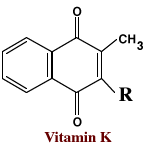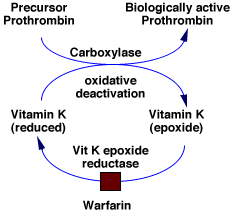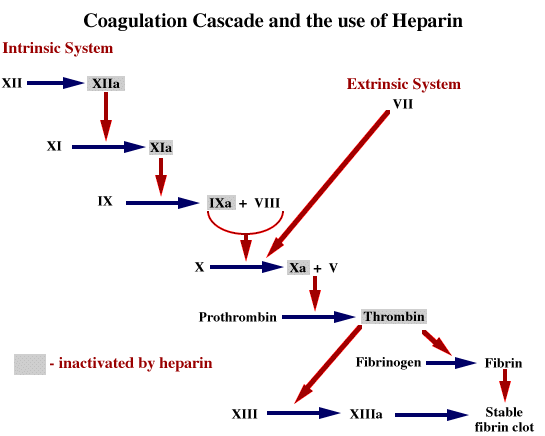
How does Warfarin actually work?
Firstly we must look at the actual process of blood clotting to understand how Warfarin has an effect on it. The clotting of blood requires certain key substances to be present in the blood stream:
The factors are:
| Factor: | Name: |
I |
Fibrinogen |
II |
Prothrombin |
III |
Tissue Thromboplastin |
IV |
Ionised Calcium |
V |
Proaccelerin/Labile Factor |
VI |
Unassigned |
VII |
Proconvertin/Stable Factor |
VIII |
Antihaemophilic Factor |
IX |
Plasma Thromboplastin component |
X |
Stuart Prower Factor |
XI |
Plasma Thromboplastin anticedent |
XII |
Hageman Factor |
XIII |
Fibrin Stabilising Factor |
Clotting can occur via two different pathways. These are:-
Warfarin blocks the re-use of Vitamin K in your liver.

Vitamin K is vital for the formation of the clotting factors II, VII, IX and X. As well as the anticoagulant proteins C and S.

The chart above show that Warfarin interferes with the vitamin K cycle. It interacts with the reductase enzyme which means that oxidised vitamin K cannot be converted back to vitamin K. This in turn means, as shown above, that the amount of reduced vitamin K will also decrease. The carboxylation of Precursor Prothrombin (Factor II) to Biologically active Prothrombin requires reduced vitamin K. Hence if the amount of reduced vitamin K is decreased this means that biologically active Prothrombin will not be formed and hence the clotting pathway will be interrupted therefore leading to a reduction in blood coagulation.

Heparin is an anticoagulant that is administered via injection.
It can be seen how the inhibition of the Factors II (Prothrombin), VII, IX and X have an effect on the formation of a stable fibrin clot. The inhibition of Factor VII has a direct effect on the extrinsic pathway. By inhibiting this factor the whole pathway is blocked. Factor IX and X have an effect early on in the intrinsic pathway.Inhibiting Factor X has a double effect on the extrinsic pathway because if there is still some factor VII in the blood stream it will have no factor X to react with. Hence, it is very unlikely that any Xa and V will be formed to carry on the pathway towards the stable fibrin clot. The inhibition of Prothrombin then has an effect on the production of Thrombin and hence the clot as well. Overall the inhibition of these 4 factors has a major effect on the ability of the body to form a stable fibrin clot.